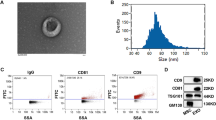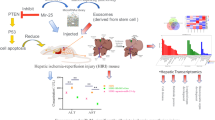Abstract
Chronic liver damage (CLD) encompasses a spectrum of conditions and poses a significant global health challenge, affecting millions of individuals. Currently, there is a deficiency of clinically validated therapeutics with minimal side effects. Emerging evidence underscores the significant potential of extracellular vesicles derived from bone marrow mesenchymal stem cells (BMSC-EVs) as a promising therapeutic method for CLD. This study aimed to evaluate the influence of BMSC-EVs containing microRNA-136-5p (BMSC-EVs-miR-136-5p) on macrophage polarization during chronic liver injury and elucidate the mechanisms associated with the GNAS/PI3K/ERK/STAT3 axis. Surface markers of BMSCs were detected via Immunofluorescent Staining. Subsequently, EVs were harvested from the BMSC culture medium. In vivo fluorescence imaging was employed to locate the BMSC-EVs. Additionally, fluorescence microscopy was used to visualize the uptake of DIR-labeled BMSC-EVs by RAW264.7 cells. Various methods were employed to assess the impact of BMSC-EVs on the expression levels of inflammatory factors (IL-1β, IL-6, IL-10, and TNF-α), M1/M2 macrophage markers (iNOS and Arg-1), and members of inflammation-related signaling pathways (GNAS, PI3K, ERK, and STAT3) in RAW264.7 cells co-cultured with BMSC-EVs. Loss-of-function approaches targeting miR-136-5p in RAW264.7 cells were subsequently utilized to validate the role of BMSC-EVs-miR-136-5p. The Luciferase Reporter Assay indicates that GNAS was identified to be a target of miR-136-5p, and miR-136-5p demonstrating increased within BMSC-EVs compared to Raw264.7-EVs. BMSC-EVs-miR-136-5p mitigated CCl4-induced liver inflammation and improved liver function by Suppressing the GNAS/STAT3 Signaling. Notably, miR-136-5p suppressed lipopolysaccharide (LPS)-induced inflammation in RAW264.7 cells. BMSC-EVs-miR-136-5p alleviates CLD by activating M2 polarization through the GNAS-mediated PI3K/ERK/STAT3 axis. Accordingly, the members of this axis may serve as therapeutic targets.








Similar content being viewed by others
Data availability
The datasets used and/or analyzed during the current study are available from the corresponding author on reasonable request.
References
Carvalho AB, Quintanilha LF, Dias JV, Paredes BD, Mannheimer EG, Carvalho FG, Asensi KD, Gutfilen B, Fonseca LM, Resende CM, Rezende GF, Takiya CM, de Carvalho AC, Goldenberg RC (2008) Bone marrow multipotent mesenchymal stromal cells do not reduce fibrosis or improve function in a rat model of severe chronic liver injury. Stem Cells 26:1307–1314. https://doi.org/10.1634/stemcells.2007-0941
Heo SK, Yu HM, Kim D, Seo HJ, Shin Y, Kim SA, Kim M, Kim Y, Lee YJ, Noh EK, Jo JC (2023) LIGHT (TNFSF14) promotes the differentiation of human bone marrow-derived mesenchymal stem cells into functional hepatocyte-like cells. Plos One. https://doi.org/10.1371/journal.pone.0289798
Yu S, Yu S, Liu H, Liao N, Liu X (2023) Enhancing mesenchymal stem cell survival and homing capability to improve cell engraftment efficacy for liver diseases. Stem Cell Res Ther 14:235. https://doi.org/10.1186/s13287-023-03476-4
Zhangdi H, Geng X, Li N, Xu R, Hu Y, Liu J, Zhang X, Qi J, Tian Y, Qiu J, Huang S, Cang X, Jin S (2023) BMSCs alleviate liver cirrhosis by regulating Fstl1/Wnt/beta-catenin signaling pathway. Heliyon 9:e21010. https://doi.org/10.1016/j.heliyon.2023.e21010
Li ZH, Chen JF, Zhang J, Lei ZY, Wu LL, Meng SB, Wang JL, Xiong J, Lin DN, Wang JY, Gao ZL, Lin BL (2023) Mesenchymal stem cells promote polarization of M2 macrophages in mice with acute-on-chronic liver failure via Mertk/JAK1/STAT6 signaling. Stem Cells. https://doi.org/10.1093/stmcls/sxad069
Wang J, Ding H, Zhou J, Xia S, Shi X, Ren H (2022) Transplantation of mesenchymal stem cells attenuates acute liver failure in mice via an interleukin-4-dependent switch to the M2 macrophage anti-inflammatory phenotype. J Clin Transl Hepatol 10:669–679. https://doi.org/10.14218/JCTH.2021.00127
Psaraki A, Ntari L, Karakostas C, Korrou-Karava D, Roubelakis MG (2022) Extracellular vesicles derived from mesenchymal stem/stromal cells: the regenerative impact in liver diseases. Hepatology 75:1590–1603. https://doi.org/10.1002/hep.32129
Zhang Y, Zhang X, Zhang H, Song P, Pan W, Xu P, Wang G, Hu P, Wang Z, Huang K, Zhang X, Wang H, Zhang J (2021) Mesenchymal stem cells derived extracellular vesicles alleviate traumatic hemorrhagic shock induced hepatic injury via IL-10/PTPN22-mediated M2 Kupffer cell polarization. Front Immunol 12:811164. https://doi.org/10.3389/fimmu.2021.811164
Shiue SJ, Rau RH, Shiue HS, Hung YW, Li ZX, Yang KD, Cheng JK (2019) Mesenchymal stem cell exosomes as a cell-free therapy for nerve injury-induced pain in rats. Pain 160:210–223. https://doi.org/10.1097/j.pain.0000000000001395
Khayati S, Dehnavi S, Sadeghi M, TavakolAfshari J, Esmaeili SA, Mohammadi M (2023) The potential role of miRNA in regulating macrophage polarization. Heliyon 9:e21615. https://doi.org/10.1016/j.heliyon.2023.e21615
Yoshikawa H, Sato T, Horikoshi K, Komura M, Nitta NA, Mitsui A, Koike K, Kodama Y, Takahashi K (2023) miR-146a regulates emphysema formation and abnormal inflammation in the lungs of two mouse models. Am J Physiol Lung Cell Mol Physiol. https://doi.org/10.1152/ajplung.00080.2023
Luo S, Chen XH (2023) Tissue and serum miR-149-3p/5p in hospitalized patients with inflammatory bowel disease: correlation with disease severity and inflammatory markers. Kaohsiung J Med Sci. https://doi.org/10.1002/kjm2.12784
Dong H, Jian P, Yu M, Wang L (2020) Silencing of long noncoding RNA LEF1-AS1 prevents the progression of hepatocellular carcinoma via the crosstalk with microRNA-136-5p/WNK1. J Cell Physiol 235:6548–6562. https://doi.org/10.1002/jcp.29503
Shiu T-Y, Lin H-H, Shih Y-L, Feng A-C, Huang H-H, Huang T-Y, Hsieh C-B, Chang W-K, Hsieh T-Y (2021) CRNDE-h transcript/miR-136–5p axis regulates interleukin enhancer binding factor 2 expression to promote hepatocellular carcinoma cell proliferation. Life Sciences. https://doi.org/10.1016/j.lfs.2021.119708
Zhu Y, Li B, Xu G, Han C, Xing G (2021) lncRNA MIR4435-2HG promotes the progression of liver cancer by upregulating B3GNT5 expression. Mol Med Rep. https://doi.org/10.3892/mmr.2021.12554
Ding H, Zhang X, Su Y, Jia C, Dai C (2020) GNAS promotes inflammation-related hepatocellular carcinoma progression by promoting STAT3 activation. Cell Mol Biol Lett 25:8. https://doi.org/10.1186/s11658-020-00204-1
Urzì O, Bagge RO, Crescitelli R (2022) The dark side of foetal bovine serum in extracellular vesicle studies. J Extracell Vesicles. https://doi.org/10.1002/jev2.12271
Asrani SK, Devarbhavi H, Eaton J, Kamath PS (2019) Burden of liver diseases in the world. J Hepatol 70:151–171. https://doi.org/10.1016/j.jhep.2018.09.014
Juanola O, Martinez-Lopez S, Frances R, Gomez-Hurtado I (2021) Non-alcoholic fatty liver disease: metabolic, genetic, epigenetic and environmental risk factors. Int J Environ Res Public Health. https://doi.org/10.3390/ijerph18105227
Mansouri A, Gattolliat CH, Asselah T (2018) Mitochondrial dysfunction and signaling in chronic liver diseases. Gastroenterology 155:629–647. https://doi.org/10.1053/j.gastro.2018.06.083
Yang B, Zang J, Yuan W, Jiang X, Zhang F (2021) The miR-136-5p/ROCK1 axis suppresses invasion and migration, and enhances cisplatin sensitivity in head and neck cancer cells. Exp Ther Med 21:317. https://doi.org/10.3892/etm.2021.9748
Chen P, Zhao L, Pan X, Jin L, Lin C, Xu W, Xu J, Guan X, Wu X, Wang Y, Yang S, Wang T, Lai Y (2018) Tumor suppressor microRNA-136-5p regulates the cellular function of renal cell carcinoma. Oncol Lett 15:5995–6002. https://doi.org/10.3892/ol.2018.8081
Cheng Y (2023) Hsa-circ-0000098 promotes the progression of hepatocellular carcinoma by regulation of miR-136-5p/MMP2 axis. Adv Clin Exp Med 32:689–700. https://doi.org/10.17219/acem/157063
Mao Y, Ding Z, Jiang M, Yuan B, Zhang Y, Zhang X (2022) Circ_0091579 exerts an oncogenic role in hepatocellular carcinoma via mediating miR-136-5p/TRIM27. Biomed J 45:883–895. https://doi.org/10.1016/j.bj.2021.12.009
Ding H, Ye ZH, Wen DY, Huang XL, Zeng CM, Mo J, Jiang YQ, Li JJ, Cai XY, Yang H, Chen G (2017) Downregulation of miR-136-5p in hepatocellular carcinoma and its clinicopathological significance. Mol Med Rep 16:5393–5405. https://doi.org/10.3892/mmr.2017.7275
He W, Zhu X, Tang X, Xiang X, Yu J, Sun H (2022) Circ_0027089 regulates NACC1 by targeting miR-136-5p to aggravate the development of hepatitis B virus-related hepatocellular carcinoma. Anticancer Drugs 33:e336–e348. https://doi.org/10.1097/CAD.0000000000001211
Shiu TY, Lin HH, Shih YL, Feng AC, Huang HH, Huang TY, Hsieh CB, Chang WK, Hsieh TY (2021) CRNDE-h transcript/miR-136-5p axis regulates interleukin enhancer binding factor 2 expression to promote hepatocellular carcinoma cell proliferation. Life Sci 284:119708. https://doi.org/10.1016/j.lfs.2021.119708
Huang X, Wang Z, Hou S, Yue C, Li Z, Hu W, Lu H (2022) Long non-coding RNA DSCAM-AS1 promotes pancreatic cancer progression via regulating the miR-136-5p/PBX3 axis. Bioengineered 13:4153–4165. https://doi.org/10.1080/21655979.2021.2016326
Li Z, Xie Y, Xiao B, Guo J (2022) The tumor suppressor function of hsa_circ_0006282 in gastric cancer through PTEN/AKT pathway. Int J Clin Oncol 27:1562–1569. https://doi.org/10.1007/s10147-022-02210-z
Kuang F, Wang B, You T, Liu Y, Li P, Wang J, Peng L (2023) Circ_0001818 targets mir-136-5p to increase lipopolysaccharide-induced Hk2 cell injuries by activating Txnip/Nlrp3 inflammasome pathway. Shock 60:110–120. https://doi.org/10.1097/SHK.0000000000002140
Yang J, Qi F, Tan B, Dai G, Chen R, Wan W, Cheng B, Xue B (2022) circSPECC1 promotes bladder cancer progression via regulating miR-136-5p/GNAS axis. Pathol Res Pract 234:153914. https://doi.org/10.1016/j.prp.2022.153914
Parish AJ, Nguyen V, Goodman AM, Murugesan K, Frampton GM, Kurzrock R (2018) GNAS, GNAQ, and GNA11 alterations in patients with diverse cancers. Cancer 124:4080–4089. https://doi.org/10.1002/cncr.31724
Jin X, Zhu L, Cui Z, Tang J, Xie M, Ren G (2019) Elevated expression of GNAS promotes breast cancer cell proliferation and migration via the PI3K/AKT/Snail1/E-cadherin axis. Clin Transl Oncol 21:1207–1219. https://doi.org/10.1007/s12094-019-02042-w
Wang X, Wang K, Qiu C, Wang B, Zhang X, Ma Y, Dai L, Zhang JY (2022) Autoantibody to GNAS in early detection of hepatocellular carcinoma: a large-scale sample study combined with verification in serial sera from HCC patients. Biomedicines. https://doi.org/10.3390/biomedicines10010097
Nault JC, Fabre M, Couchy G, Pilati C, Jeannot E, Tran Van Nhieu J, Saint-Paul MC, De Muret A, Redon MJ, Buffet C, Salenave S, Balabaud C, Prevot S, Labrune P, Bioulac-Sage P, Scoazec JY, Chanson P, Zucman-Rossi J (2012) GNAS-activating mutations define a rare subgroup of inflammatory liver tumors characterized by STAT3 activation. J Hepatol 56:184–191. https://doi.org/10.1016/j.jhep.2011.07.018
Han H, Ding G, Wang S, Meng J, Lv Y, Yang W, Zhang H, Wen X, Zhao W (2023) Long non-coding RNA LOC339059 attenuates IL-6/STAT3-signaling-mediated PDL1 expression and macrophage M2 polarization by interacting with c-myc in gastric cancer. Cancers (Basel). https://doi.org/10.3390/cancers15225313
Deswal B, Bagchi U, Kapoor S (2023) Curcumin suppresses M2 macrophage-derived paclitaxel chemoresistance through inhibition of PI3k-AKT/STAT3 signaling. Anticancer Agents Med Chem. https://doi.org/10.2174/0118715206275259231105184959
Zhang Y, Zhang L, Zhao Y, He J, Zhang Y, Zhang X (2023) PGC-1alpha inhibits M2 macrophage polarization and alleviates liver fibrosis following hepatic ischemia reperfusion injury. Cell Death Discov 9:337. https://doi.org/10.1038/s41420-023-01636-2
Acknowledgements
The authors would like to thank the reviewers and also the authors of all references.
Funding
This work was supported by grants from the National Natural Science Foundation of China (to Wenlan Liu) (Grant No. 81573879) and the Natural Science Foundation of Beijing (to Wenlan Liu) (Grant No. 7182021).
Author information
Authors and Affiliations
Contributions
Xiaodan Jiang as principal author was responsible for processing experiments, collecting, and analyzing data, finally independently wrote this manuscript. Wenlan Liu performed conception and design of study and reviewed manuscript, and acted as corresponding author. Zhejun Liu and Ruifang Nie contributed to complete experiments. Hongjie You, Zuoqing Tang, Yun Ma, Zheng Yang, and Niancong Che contributed to data interpretation.
Corresponding author
Ethics declarations
Competing interest
The authors declare that they have no conflict of interest to declare.
Consent to participate
The consent for approval and participate are not applicable.
Consent for publication
The consent for publication are not applicable.
Additional information
Publisher's Note
Springer Nature remains neutral with regard to jurisdictional claims in published maps and institutional affiliations.
Rights and permissions
Springer Nature or its licensor (e.g. a society or other partner) holds exclusive rights to this article under a publishing agreement with the author(s) or other rightsholder(s); author self-archiving of the accepted manuscript version of this article is solely governed by the terms of such publishing agreement and applicable law.
About this article
Cite this article
Jiang, X., Liu, Z., You, H. et al. Extracellular vesicles derived from bone marrow mesenchymal stem cells ameliorate chronic liver damage via microRNA-136-5p. Mol Cell Biochem (2024). https://doi.org/10.1007/s11010-024-04993-3
Received:
Accepted:
Published:
DOI: https://doi.org/10.1007/s11010-024-04993-3




